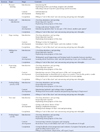Abstract
Purpose
This study was done to verify effects of a positive psychotherapy program on depression, self-esteem, and hope in patients with major depressive disorders.
Methods
A nonequivalent control group pre-post design was used. Participants were 53 people (control group=27 and experimental group=26) who were diagnosed with a major depressive disorder and received psychiatric outpatient treatment. The data were collected from July 1 to December 30, 2013. The experimental group received the positive psychotherapy program 8 times over 8 weeks. Data analysis was conducted using χ2-test, Fisher's exact test and t-test.
Figures and Tables
References
1. Jae YM. Suicide and psychotic disorder. J Korean Soc Biol Ther Psychiatry. 2004; 10(1):3–10.
2. Seligman ME, Rashid T, Parks AC. Positive psychotherapy. Am Psychol. 2006; 61(8):744–788. DOI: 10.1037/0003-066x.61.8.774.

3. Lim YJ. Efficacy of positive psychotherapy on college students with major depressive disorder. KJCP. 2012; 31(3):679–692.

4. Kwon SM. Positive psychology. Seoul: Hakjisa;2008. p. 622.
5. Maddux JE, Snyder CR, Lopez SJ. Toward a positive clinical psychology: deconstructing the illness ideology and constructing an ideology of human strengths and potential. Positive psychology in practice. Hoboken, NJ, US: John Wiley & Sons Inc;2004. p. 320–334. DOI: 10.1002/9780470939338.ch20.
6. Campbell JD. Self-esteem and clarity of self-concept. J Pers Soc Psychol. 1990; 59(3):538–549. DOI: 10.1037//0022-3514.59.3.538.
7. Yeo JH, Hyun MY, Lee EJ, Park EO, Kim JH, Song HJ. Psychosocial maturity, depression and self-esteem in undergraduate students. J Korean Acad Psychiatr Ment Health Nurs. 2005; 14(1):73–81.
8. Beck AT. Depression: clinical, experimental and theoretical aspects. New York: Harper & Row;1967. p. 370.
9. Snyder CR, Feldman DB. C, A, Lewis & A, Hill. The state hope scale. a handbook of psychological tests. Maltby: 2000. p. 240–245.
10. Kim JE. Experience of hope in terminal cancer patients: applying Parse's theory of becoming a human being [dissertation]. [Gwangju]: Cheonnam National University;2010. 118.
11. Seligman ME, Schulman P, Tryon AM. Group prevention of depression and anxiety symptoms. Behav Res Ther. 2007; 45(6):1111–1126. DOI: 10.1016/j.brat.2006.09.010.

12. Snyder CR, Sympson SC, Ybasco FC, Borders TF, Babyak MA, Higgins RL. Development and validation of the state hope scale. J Pers Soc Psychol. 1996; 70:321–335. DOI: 10.1037//0022-3514.70.2.321.

13. Tollet H, Thomas HP. A theory-based nursing intervention to instill hope in homeless veterans. ANS Adv Nurs Sci. 1995; 18(2):76–90.

14. Sung MH, Chun SM, Lim OK, Kim EK. The effects of a positive psychotherapy program on depression, self-esteem and school adjustment of depressive elementary school students. Korea J East West Mind Sci. 2012; 15(1):43–58.
15. Yoo EY, Son CN. Effects of positive psychotherapy program on happiness, optimism, hopelessness, and depression of the depression-prone adolescents. KJHP. 2013; 18(4):669–685.

16. Kim JY, Ko YG. Positive clinical psychology: focusing on mental fitness and positive psychotherapy. Korean Psychological J Culture Soc Issues. 2009; 15(1):155–168.
17. Beck AT, Steer RA, Brown GK. Beck depression inventory. 2nd Manual. San Antonio. TX: The Psychological Corporation;1996.
18. Sung HM, Kim JB, Park YN, Bai DS, Lee SN, Ahn HN. A study on the reliability and the validity of Korean version of the Beck Depression Inventory-II (BDI -II). J Korean Soc Biol Ther Psychiatry. 2008; 14(2):201–212.
19. Rosenberg M. Society and the adolescent self-image. Princeton, N.J.: Princeton University Press;1965. p. 326.
20. Jeon BJ. Self-esteem: a test of its measurability. J Yonsei Nonchong. 1974; 11(1):107–130.
21. Snyder CR, Harris C, Anderson JR, Holleran SA, Irving LM. The will and the ways: development and validation of an individual-differences measures of hope. J Pers Soc Psychol. 1991; 60(4):570–585. DOI: 10.1037/0022-3514.60.4.570.

22. Kim TH. The mediate effects of hope and meaning of life on adolescents' resilience. Korea J Couns. 2004; 5(3):743–772.
23. Kim JY, Lim YJ. Depressive symptoms as a predictor of response to positive psychotherapy for adolescents. KJRP. 2015; 22(1):1–10.
24. Kim MK. The effect of group positive psychology program on self-esteem, happiness of adolescent [master's thesis]. [Seoul]: Korea University;2011. 63.
25. Jeong JH, Son CN. Effects of positive psychotherapy on depression, self-esteem, and optimism of adolescents with school maladjustments. KJHP. 2014; 19(1):99–117.

26. Sung MH, Choi MY, Eum OB. Effects of hand holding on self-esteem and assertiveness in women patients with depression. J Korean Acad Psychiatr Ment Health Nurs. 2010; 19(2):154–162.

27. Key CLM, Lopez SJ. Toward a science of mental health: positive direction in diagnosis and intervention. C. R Snyder & Lopez. Handbook of positive psychology. New York: Oxford University Press;2001. p. 848.
28. Park MK, Lee YS. The effects of the hope enhancement group counseling program on learning motivation and achievement goal orientation of the middle school students. Korea J Couns. 2011; 12(2):505–522.

29. Magaletta PR, Oliver JM. The hope construct, will, and ways: their relations with self-efficacy, optimism, and general well-being. J Clin Psychology. 1999; 55(5):539–551.

30. Hong HJ. The effects of positive psychology group counseling program on depression, hope and optimism of adolescents [master's thesis]. [Gwangju]: Cheonnam National University;2012. 110.




 PDF
PDF ePub
ePub Citation
Citation Print
Print






 XML Download
XML Download